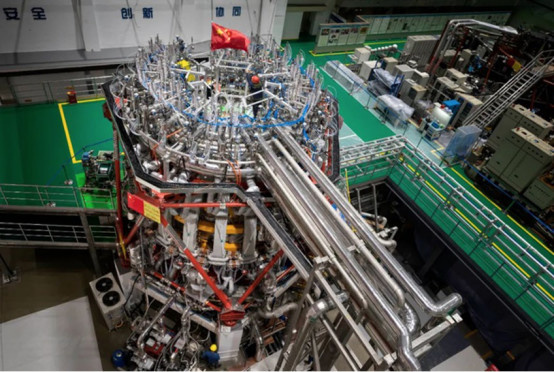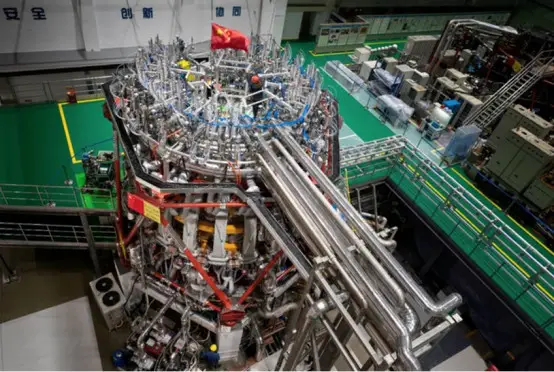Jiang Jianke, People's Daily

Photo shows China's new-generation "artificial sun," the HL-2M. (Photo courtesy of the Southwestern Institute of Physics of the China National Nuclear Corporation).
With its plasma current exceeding one million amperes, China's new-generation "artificial sun," the HL-2M, has set a new record in the country for the operation of a controlled nuclear fusion device, according to the data analysis team of the Southwestern Institute of Physics of the China National Nuclear Corporation (CNNC).
This breakthrough marks a further step China has taken toward research and development (R&D) of nuclear fusion ignition. It also indicates that the country is among the first echelon in the world in research concerning this field and that the country is in a leading position globally in this technology.
The HL-2M, a Tokamak device, is the country's largest in scale and highest in parameters. The plasma current is a core parameter of the Tokamak fusion reactor. A plasma current of one million amperes is necessary for nuclear fusion. In the future, Tokamaks must rely on plasma currents at the mega-ampere level in order to maintain steady operation.
Tokamak is a mainstream device used for research on controlled nuclear fusion. It features a vacuum chamber to hold plasmas with a temperature of 100 million degrees Celsius for a long time for a steady and sustainable fusion reaction. Because the way through which energy is generated inside the device is similar to the way the sun generates energy, Tokamak is also figuratively called the "artificial sun."
Zhong Wulv, deputy director of the Center for Fusion Science under the Southwestern Institute of Physics of the CNNC and head of the HL-2M experiment, stated that temperature, density, and time are three parameters that determine the creation of the fusion device and the fusion research results, and a nuclear fusion takes place only when the product of the multiplication of the three parameters exceeds a specific figure.
The HL-2M Tokamak, with a plasma current of more than 2.5 million amperes and holding plasmas with a temperature of 150 million degrees Celsius, can achieve high-density, high specific pressure, and high bootstrap current operation.
China follows a "three-step" roadmap of "thermal neutron reactor - fast reactor - controlled nuclear fusion reactor" for the development of nuclear energy. The Southwestern Institute of Physics of the CNNC, as a core institute in R&D of controlled nuclear fusion reactor and an important support institute for the country's participation in the International Thermonuclear Experimental Reactor (ITER), has developed various types of magnetic confinement fusion devices.
The HL-1, the first Tokamak device independently built by China in 1984, is an important milestone in the country's history of nuclear fusion reaction research. It has accumulated a wealth of experience for China in independently designing, building and operating nuclear fusion devices, Wu introduced.
On Dec. 4, 2020, a new generation of "artificial sun" independently designed and built by the Southwestern Institute of Physics of the CNNC was completed and achieved its first plasma discharge after it went into operation, marking an important progress made by China in the fields of basic research and original innovation.
In the future, the HL-2M Tokamak will continue to be used to carry out experiments in an orderly manner. It will strive for a higher plasma current and a higher plasma temperature, as well as an increase in the three parameters of nuclear fusion, thus making new progress in China's research on the "artificial sun."
This breakthrough marks a further step China has taken toward research and development (R&D) of nuclear fusion ignition. It also indicates that the country is among the first echelon in the world in research concerning this field and that the country is in a leading position globally in this technology.
The HL-2M, a Tokamak device, is the country's largest in scale and highest in parameters. The plasma current is a core parameter of the Tokamak fusion reactor. A plasma current of one million amperes is necessary for nuclear fusion. In the future, Tokamaks must rely on plasma currents at the mega-ampere level in order to maintain steady operation.
Tokamak is a mainstream device used for research on controlled nuclear fusion. It features a vacuum chamber to hold plasmas with a temperature of 100 million degrees Celsius for a long time for a steady and sustainable fusion reaction. Because the way through which energy is generated inside the device is similar to the way the sun generates energy, Tokamak is also figuratively called the "artificial sun."
Zhong Wulv, deputy director of the Center for Fusion Science under the Southwestern Institute of Physics of the CNNC and head of the HL-2M experiment, stated that temperature, density, and time are three parameters that determine the creation of the fusion device and the fusion research results, and a nuclear fusion takes place only when the product of the multiplication of the three parameters exceeds a specific figure.
The HL-2M Tokamak, with a plasma current of more than 2.5 million amperes and holding plasmas with a temperature of 150 million degrees Celsius, can achieve high-density, high specific pressure, and high bootstrap current operation.
China follows a "three-step" roadmap of "thermal neutron reactor - fast reactor - controlled nuclear fusion reactor" for the development of nuclear energy. The Southwestern Institute of Physics of the CNNC, as a core institute in R&D of controlled nuclear fusion reactor and an important support institute for the country's participation in the International Thermonuclear Experimental Reactor (ITER), has developed various types of magnetic confinement fusion devices.
The HL-1, the first Tokamak device independently built by China in 1984, is an important milestone in the country's history of nuclear fusion reaction research. It has accumulated a wealth of experience for China in independently designing, building and operating nuclear fusion devices, Wu introduced.
On Dec. 4, 2020, a new generation of "artificial sun" independently designed and built by the Southwestern Institute of Physics of the CNNC was completed and achieved its first plasma discharge after it went into operation, marking an important progress made by China in the fields of basic research and original innovation.
In the future, the HL-2M Tokamak will continue to be used to carry out experiments in an orderly manner. It will strive for a higher plasma current and a higher plasma temperature, as well as an increase in the three parameters of nuclear fusion, thus making new progress in China's research on the "artificial sun."
 Menu
Menu
 China makes new progress in research on "artificial sun"
China makes new progress in research on "artificial sun"
















